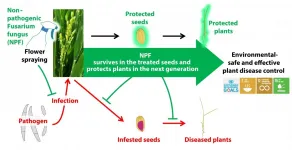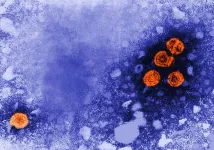(Press-News.org) ADELPHI, Md. -- A new quantum sensor can analyze the full spectrum of radio frequency and real-world signals, unleashing new potentials for soldier communications, spectrum awareness and electronic warfare.
Army researchers built the quantum sensor, which can sample the radio-frequency spectrum--from zero frequency up to 20 GHz--and detect AM and FM radio, Bluetooth, Wi-Fi and other communication signals.
The Rydberg sensor uses laser beams to create highly-excited Rydberg atoms directly above a microwave circuit, to boost and hone in on the portion of the spectrum being measured. The Rydberg atoms are sensitive to the circuit's voltage, enabling the device to be used as a sensitive probe for the wide range of signals in the RF spectrum.
"All previous demonstrations of Rydberg atomic sensors have only been able to sense small and specific regions of the RF spectrum, but our sensor now operates continuously over a wide frequency range for the first time," said Dr. Kevin Cox, a researcher at the U.S. Army Combat Capabilities Development Command, now known as DEVCOM, Army Research Laboratory. "This is a really important step toward proving that quantum sensors can provide a new, and dominant, set of capabilities for our Soldiers, who are operating in an increasingly complex electro-magnetic battlespace."
The Rydberg spectrum analyzer has the potential to surpass fundamental limitations of traditional electronics in sensitivity, bandwidth and frequency range. Because of this, the lab's Rydberg spectrum analyzer and other quantum sensors have the potential to unlock a new frontier of Army sensors for spectrum awareness, electronic warfare, sensing and communications--part of the Army's modernization strategy.
"Devices that are based on quantum constituents are one of the Army's top priorities to enable technical surprise in the competitive future battlespace," said Army researcher Dr. David Meyer. "Quantum sensors in general, including the one demonstrated here, offer unparalleled sensitivity and accuracy to detect a wide range of mission-critical signals."
The peer-reviewed journal Physical Review Applied published the researchers' findings, Waveguide-coupled Rydberg spectrum analyzer from 0 to 20 GigaHerz, co-authored by Army researchers Drs. David Meyer, Paul Kunz, and Kevin Cox
The researchers plan additional development to improve the signal sensitivity of the Rydberg spectrum analyzer, aiming to outperform existing state-of-the-art technology.
"Significant physics and engineering effort is still necessary before the Rydberg analyzer can integrate into a field-testable device," Cox said. "One of the first steps will be understanding how to retain and improve the device's performance as the sensor size is decreased. The Army has emerged as a leading developer of Rydberg sensors, and we expect more cutting-edge research to result as this futuristic technology concept quickly becomes a reality."
INFORMATION:
DEVCOM Army Research Laboratory is an element of the U.S. Army Combat Capabilities Development Command. As the Army's corporate research laboratory, ARL is operationalizing science to achieve transformational overmatch. Through collaboration across the command's core technical competencies, DEVCOM leads in the discovery, development and delivery of the technology-based capabilities required to make Soldiers more successful at winning the nation's wars and come home safely. DEVCOM is a major subordinate command of the Army Futures Command.
People traditionally think that lungs and limbs are key innovations that came with the vertebrate transition from water to land. But in fact, the genetic basis of air-breathing and limb movement was already established in our fish ancestor 50 million years earlier. This, according to a recent genome mapping of primitive fish conducted by the University of Copenhagen, among others. The new study changes our understanding of a key milestone in our own evolutionary history.
There is nothing new about humans and all other vertebrates having evolved from fish. The conventional understanding has been that certain fish shimmied landwards roughly ...
A global team of researchers has developed a new strategy for fast and reliable antibody tests, which can quantify the immune response induced by vaccination and reveal the timeline and stage of pathogen infection.
Led by Professor Martin Hegner, Principal Investigator in CRANN and Trinity College Dublin's School of Physics, the team's one-step quantitative antibody tests are conducted using (blood) serum and are on a par with the gold-standard, enzyme-linked immunosorbent assay (ELISA) technique.
The major advantage of the newly developed nano technique with respect to ELISA tests is that it is equally ...
ATLANTA - Researchers at Yerkes National Primate Research Center, Emory University, have developed a COVID-19 vaccine that has proven safe and effective in mice and monkeys. Results from this National Institute of Allergy and Infectious Diseases (NIAID)-funded study are published online today in Immunity.
The Emory MVA COVID-19 vaccine approaches inducing protective immunity via modified vaccinia Ankara (MVA), a harmless version of a poxvirus that is well-known for its use in HIV/AIDS vaccines. Like the Moderna and Pfizer COVID-19 vaccines, the Emory MVA COVID-19 vaccine ...
New research carried out by City, University of London data scientist, Dr Andrea Baronchelli, and colleagues into the dark web marketplace (DWM) trade in products related to COVID-19, has revealed the need for the continuous monitoring of dark web marketplaces (DWMs) especially in light of the current shortage and availability of coronavirus vaccines.
In their paper, Dark Web Marketplaces and COVID-19: before the vaccine published in the EPJ Data Science, Dr Baronchelli and his colleagues analysed 851,199 listings extracted from 30 DWMs between January 1, 2020 and November 16, 2020 before the advent of the availability of the coronavirus vaccine.
They identify 788 listings directly related to COVID-19 ...
In data gathered and analyzed over 13 years, the North American Nanohertz Observatory for Gravitational Waves (NANOGrav) Physics Frontiers Center (PFC) has found an intriguing low-frequency signal that may be attributable to gravitational waves.
NANOGrav researchers - including a number from West Virginia University's (WVU's) Department of Physics and Astronomy and the Center for Gravitational Waves and Cosmology - measure the times of arrival of radio pulses from exotic stars called pulsars with large radio telescopes, including the Green Bank Telescope (GBT) in Pocahontas County, ...
Researchers have developed a new technique to protect rice seeds against fungal infections that can ruin up to half of all rice crops in the world. The biocontrol method, which involves inoculation of flowers with a different fungus that doesn't cause disease and using seeds harvested from the flower to grow crops, is even better at protecting rice plants from diseases than existing fungicide approaches, and could also be used against similar pathogens that affect other staple crops.
The extremely destructive seedborne bakanae disease, which affects rice plants everywhere in the world that the staple crop is grown, is currently typically combatted with either chemical fungicides or ...
The new therapeutic approach is based on shutting down the viral hepatitis B genome located in the nucleus of infected liver cells. Upon infection of the liver cell, the viral genome is transformed inside the nucleus into a closed circular DNA molecule. This deoxyribonucleic acid is a stable molecule known as covalently closed circular DNA (cccDNA) and serves as the template for the production of new viruses. The cccDNA represents the central reservoir of the hepatitis B viruses and enables their persistence in the liver. The virologist Prof. Dr. Maura Dandri and her team at the UKE managed to prevent the HBV-cccDNA from producing further viruses in the animal model.
The point of attack of their ...
Treating equine donor stem cells with a growth factor called TGF-β2 may allow them to avoid "tripping" the immune response in recipients, according to new research from North Carolina State University. The work could simplify the stem cell treatment process for ligament and tendon injuries in horses, and may also have implications for human stem cell therapies.
Mesenchymal stem cell therapy is a promising avenue for treating musculoskeletal injuries - particularly tendon and ligament injuries - in horses. Mesenchymal stem cells are adult stem cells found in bone marrow that act as repair directors, producing secretions that recruit paracrine, or healing, factors to the site of injury.
Just as blood cells have "types," ...
Gels are formed by mixing polymers into fluids to create gooey substances useful for everything from holding hair in place to enabling contact lenses to float over the eye.
Researchers want to develop gels for healthcare applications by mixing in medicinal compounds, and giving patients injections so that the gel releases the active pharmaceutical ingredient over a period of months to avoid weekly or daily needle sticks.
But standing in the way is a problem that's as easily understandable as the difference between using hair gel on a beach versus in a ...
Virtual 'exergaming' has become a popular way to exercise - especially among younger people - since the release of virtual reality (VR) fitness games on consoles such as Nintendo and Playstation.
But while VR is undoubtedly raising fitness games to a whole new level, researchers at the University of South Australia are cautioning players about the potential side effects of VR, particularly in the first hour after playing.
In a new study published in the Journal of Medical Internet Research, UniSA researchers investigated the consequences of playing one of the most popular VR exergames - Beat Saber* - finding that one in seven players still ...






